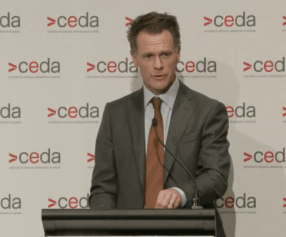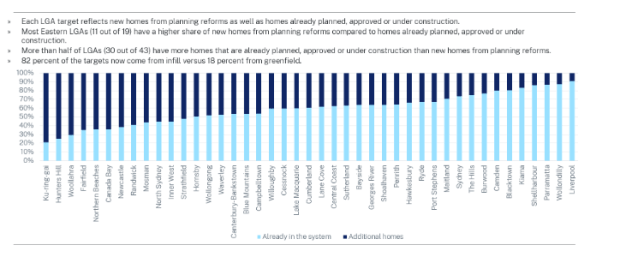The state government has announced new targets and incentives for 43 NSW councils to build more housing across Sydney, the Illawarra, the Hunter and Central Coast, and regional parts of the state.

Unveiling the plans during his first State of the State address in Sydney on Wednesday, Mr Minns said the measures would address the state’s housing crisis.
The 43 LGAs have each received a five-year target for how many homes they are expected to deliver by 2029.
For example, Penrith, in Sydney’s West, will have to come up with 8,400 new homes by 2029, while City of Sydney is required to deliver 18,900. Blue Mountains only has to hit 600 new homes in the timeframe.
Councils that meet and exceed their housing targets will be rewarded from a $200 million grants pool that they can use to fund green spaces, sports facilities and street maintenance.
Guideposts
The targets will provide guideposts for local government as well as access to financial support for future housing, Mr Minns said.
View housing targets here.
The Premier revealed that under the roadmap, Sydney’s east will carry 41 per cent of the burden, followed by middle Sydney (including Parramatta, Canterbury-Bankstown, Blacktown and Georges River) at 37 per cent and Sydney’s west accounting for the rest.
He acknowledged it would be a big change for some councils.
“In Kuringai, Hunters Hill and Woolharra more than 70 per cent of new housing will be delivered as a result of these changes, but in Liverpool, Wollondilly and Parramatta, councils that were already planning to build at scale, it will be less than 20 per cent,” he said.

In the past, Western Sydney has accepted the overwhelming burden of new housing without proper infrastructure to cope with the increase in population, Mr Minns said.
“This plan ensures we are now building more housing around established infrastructure, in places that are connected to work and transport, in communities that already have schools and hospitals.
“These five-year targets ensure that while all areas would see an increase in homes being built to help address the housing crisis, new housing will be more fairly rebalanced from the West of Sydney towards the East and North of Sydney.”
Over the next five years 82 per cent of the housing targets come from infill areas with 18 per cent to come from greenfield locations.
Planning reform
Mr Minns said it was clear that NSW had a planning system that wasn’t keeping pace with the problems the state is facing.
He said the government has signed agreements with all but one of the 13 councils targeted under it’s controversial Transport Orientated Development (TOD) – the biggest rezoning shakeup in Australian history – with Kuringai, who has vowed to take legal action against the plan, the sole outlier.
The TOD will allow major new development around 40 train stations, including more high rise housing.
Asked about repercussions for councils that failed to meet their targets, the Premier said he wasn’t holding a gun to anyone’s head.
“Our simple proposal is everybody needs to take a little bit so we can give the next generation a go,” he said.





Before carrying out these proposed building works, the first thing is to sort out all of the infer structure. Problems with hospitals traffic, schools, sewerage, water supplies, gas and electrical, storm water, parking etc would have to be upgraded.
The other problem is having people to do this work and supervise that it being built properly and on time.
Maybe it might pay to build some cities in new areas around commerce and industry without rushing it.
Hunters Hill already has traffic issues feeding onto Victoria Road, and at times becomes a “parking Lot” into the City.
Why focus on the east when there is the new airport being built out west. Why not more hubs like Parramatta out west so people don’t have to travel to the CBD or east to work, they can work and live locally. Entice big business to go west or at least establish offices there. I know alot of my colleagues would prefer that instead of having to drive all the way to the office in Macquarie Park.
It should spread equally amongst the whole of NSW, not exclude some areas where wealthy people don’t want the issues associated with high density housing. Premier Minns, how many are allocated for where you live?
Why is Blue Mountains only 600 for instance?: Interesting that Mosman is only 500 and Sutherland is only 6000. Yet Canterbury Bankstown is 14500.
Allocate it fairly and not show favourtism.
Not good and the plan just turns some areas into gettos whilst others are basically untouched.
It’s a small political start !!
A further thought,
The article as below:
Asked about repercussions for councils that failed to meet their targets, the Premier said he wasn’t holding a gun to anyone’s head.
“Our simple proposal is everybody needs to take a little bit so we can give the next generation a go,” he said.
The proposal is not simple and the implications are long term for the existing residents who bought in low density areas and paid a premium for this. Your plans will degrade our areas and our quality of life due to the uneven allocation in the proposal.
Some areas have already had this increase in the last 4 to 5 years with the overdevelopment of duplex and multi storey dwellings. These numbers need to be taken into account when setting numbers.
If only we could all afford to live in the unaffected areas of the Sutherland Shire, Mosman etc. This policy needs some serious review to take into account the quality of life of the existing residents as well.
All smoke and mirrors.
This is a nonsense policy if the NSW State Government was genuine they would take a step back in time and mandate a big increase in public housing, historically public housing accounted for 30% of all new homes before Labor/Liberal Governments decided Privatisation and Market Liberalism would provide the housing needs of our society. This is a big factor in the lack of affordable housing and of course the runaway profits for those that make their money from speculation in the housing/property markets. Now with an economy sliding into recession and a record number of the shonky/greed brigade in the Construction Industry liquidating to profit at a later date, consumers who no longer have the ability to pay what this rancid market is asking and who is going to build the affordable homes we need?